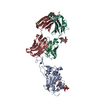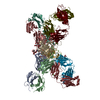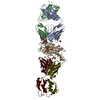[English] 日本語
 Yorodumi
Yorodumi- PDB-8cwj: Fab arms of antibodies 4C12-B12 and CR3022 bound to pangolin rece... -
+ Open data
Open data
- Basic information
Basic information
| Entry | Database: PDB / ID: 8cwj | ||||||
|---|---|---|---|---|---|---|---|
| Title | Fab arms of antibodies 4C12-B12 and CR3022 bound to pangolin receptor binding domain (pRBD) | ||||||
 Components Components |
| ||||||
 Keywords Keywords | IMMUNE SYSTEM / antibody / pangolin / receptor binding domain / class 5 epitope | ||||||
| Function / homology |  Function and homology information Function and homology informationhost cell endoplasmic reticulum-Golgi intermediate compartment membrane / receptor-mediated virion attachment to host cell / endocytosis involved in viral entry into host cell / fusion of virus membrane with host plasma membrane / fusion of virus membrane with host endosome membrane / viral envelope / host cell plasma membrane / virion membrane / membrane Similarity search - Function | ||||||
| Biological species |  Homo sapiens (human) Homo sapiens (human) Pangolin coronavirus Pangolin coronavirus | ||||||
| Method |  X-RAY DIFFRACTION / X-RAY DIFFRACTION /  SYNCHROTRON / SYNCHROTRON /  MOLECULAR REPLACEMENT / MOLECULAR REPLACEMENT /  molecular replacement / Resolution: 2.449 Å molecular replacement / Resolution: 2.449 Å | ||||||
 Authors Authors | Langley, D.B. / Christ, D. | ||||||
| Funding support |  Australia, 1items Australia, 1items
| ||||||
 Citation Citation |  Journal: Proc Natl Acad Sci U S A / Year: 2025 Journal: Proc Natl Acad Sci U S A / Year: 2025Title: Affinity maturation endows potent activity onto class 6 SARS-CoV-2 broadly neutralizing antibodies. Authors: Ohan Mazigi / David B Langley / Jake Y Henry / Deborah L Burnett / Meghna Sobti / Gregory J Walker / Romain Rouet / Harikrishnan Balachandran / Helen Lenthall / Jennifer Jackson / Stephanie ...Authors: Ohan Mazigi / David B Langley / Jake Y Henry / Deborah L Burnett / Meghna Sobti / Gregory J Walker / Romain Rouet / Harikrishnan Balachandran / Helen Lenthall / Jennifer Jackson / Stephanie Ubiparipovic / Peter Schofield / Simon H J Brown / Sebastian R Schulz / Markus Hoffmann / Stefan Pöhlmann / Jeffrey Post / Marianne Martinello / Golo Ahlenstiel / Anthony Kelleher / William D Rawlinson / Stuart G Turville / Rowena A Bull / Alastair G Stewart / Hans-Martin Jäck / Christopher C Goodnow / Daniel Christ /   Abstract: The emergence of SARS-CoV-2 variants of concern (VOCs) has greatly diminished the neutralizing activity of previously FDA-approved monoclonal antibodies (mAbs), including that of antibody cocktails ...The emergence of SARS-CoV-2 variants of concern (VOCs) has greatly diminished the neutralizing activity of previously FDA-approved monoclonal antibodies (mAbs), including that of antibody cocktails and of first-generation broadly neutralizing antibodies such as S309 (Sotrovimab). In contrast, antibodies targeting cryptic conformational epitopes of the receptor binding domain (RBD) have demonstrated broad activity against emerging variants, but exert only moderate neutralizing activity, which has so far hindered clinical development. Here, we utilize in vitro display technology to identify and affinity-mature antibodies targeting the cryptic class 6 epitope, accessible only in the "up" conformation of the SARS-CoV-2 spike trimer. Increasing antibody affinity into the low picomolar range endowed potent neutralization of VOCs and protection of hACE2 mice from viral challenge. Cryoelectron microscopy and crystal structures of two affinity-matured antibodies (4C12-B12 and 4G1-C2) in complex with RBD highlighted binding modes and epitopes distal from mutational hotspots commonly overserved in VOCs, providing direct structural insights into the observed mutational resistance. Moreover, we further demonstrate that antibodies targeting the class 6 epitope, rather than being an artifact of in vitro selection, are common in the IgG1 memory B cell repertoire of convalescent patients and can be induced in human antibody V-gene transgenic mice through immunization. Our results highlight the importance of very high (picomolar) affinity in the development of neutralizing antibodies and vaccines and suggest an affinity threshold in the provision of broad and long-lasting immunity against SARS-CoV-2. | ||||||
| History |
|
- Structure visualization
Structure visualization
| Structure viewer | Molecule:  Molmil Molmil Jmol/JSmol Jmol/JSmol |
|---|
- Downloads & links
Downloads & links
- Download
Download
| PDBx/mmCIF format |  8cwj.cif.gz 8cwj.cif.gz | 844.4 KB | Display |  PDBx/mmCIF format PDBx/mmCIF format |
|---|---|---|---|---|
| PDB format |  pdb8cwj.ent.gz pdb8cwj.ent.gz | 700.5 KB | Display |  PDB format PDB format |
| PDBx/mmJSON format |  8cwj.json.gz 8cwj.json.gz | Tree view |  PDBx/mmJSON format PDBx/mmJSON format | |
| Others |  Other downloads Other downloads |
-Validation report
| Arichive directory |  https://data.pdbj.org/pub/pdb/validation_reports/cw/8cwj https://data.pdbj.org/pub/pdb/validation_reports/cw/8cwj ftp://data.pdbj.org/pub/pdb/validation_reports/cw/8cwj ftp://data.pdbj.org/pub/pdb/validation_reports/cw/8cwj | HTTPS FTP |
|---|
-Related structure data
| Related structure data |  8cwiC  8cwkC C: citing same article ( |
|---|---|
| Similar structure data | Similarity search - Function & homology  F&H Search F&H Search |
- Links
Links
- Assembly
Assembly
| Deposited unit | 
| ||||||||
|---|---|---|---|---|---|---|---|---|---|
| 1 | 
| ||||||||
| 2 | 
| ||||||||
| Unit cell |
|
- Components
Components
-Protein , 1 types, 2 molecules GI
| #3: Protein | Mass: 22891.547 Da / Num. of mol.: 2 Source method: isolated from a genetically manipulated source Source: (gene. exp.)  Pangolin coronavirus / Cell line (production host): ExpiCHO / Production host: Pangolin coronavirus / Cell line (production host): ExpiCHO / Production host:  |
|---|
-Antibody , 4 types, 8 molecules HALBJUKV
| #1: Antibody | Mass: 24428.432 Da / Num. of mol.: 2 Source method: isolated from a genetically manipulated source Source: (gene. exp.)  Homo sapiens (human) / Cell line (production host): ExpCHO / Production host: Homo sapiens (human) / Cell line (production host): ExpCHO / Production host:  #2: Antibody | Mass: 24289.885 Da / Num. of mol.: 2 Source method: isolated from a genetically manipulated source Source: (gene. exp.)  Homo sapiens (human) / Cell line (production host): ExpiCHO / Production host: Homo sapiens (human) / Cell line (production host): ExpiCHO / Production host:  #4: Antibody | Mass: 24514.238 Da / Num. of mol.: 2 Source method: isolated from a genetically manipulated source Source: (gene. exp.)  Homo sapiens (human) / Cell line (production host): ExpiCHO / Production host: Homo sapiens (human) / Cell line (production host): ExpiCHO / Production host:  #5: Antibody | Mass: 23466.057 Da / Num. of mol.: 2 Source method: isolated from a genetically manipulated source Source: (gene. exp.)  Homo sapiens (human) / Cell line (production host): ExpiCHO / Production host: Homo sapiens (human) / Cell line (production host): ExpiCHO / Production host:  |
|---|
-Sugars , 2 types, 4 molecules 
| #6: Polysaccharide | Source method: isolated from a genetically manipulated source #8: Sugar | ChemComp-NAG / | |
|---|
-Non-polymers , 3 types, 388 molecules 




| #7: Chemical | ChemComp-GOL / #9: Chemical | ChemComp-CL / #10: Water | ChemComp-HOH / | |
|---|
-Details
| Has ligand of interest | N |
|---|---|
| Has protein modification | Y |
-Experimental details
-Experiment
| Experiment | Method:  X-RAY DIFFRACTION / Number of used crystals: 1 X-RAY DIFFRACTION / Number of used crystals: 1 |
|---|
- Sample preparation
Sample preparation
| Crystal | Density Matthews: 3.55 Å3/Da / Density % sol: 65.32 % / Description: tiles |
|---|---|
| Crystal grow | Temperature: 293 K / Method: vapor diffusion, hanging drop Details: Equal volumes of protein complex (1:1:1 molar ratio, at ~ 5 mg/mL, in 25 mM Tris (pH 8.0), 200 mM NaCl) were combined with well solution (200 mM sodium citrate (pH 5.6), 12% (w/v) PEG6000). |
-Data collection
| Diffraction | Mean temperature: 100 K / Serial crystal experiment: N | ||||||||||||||||||||||||||||||
|---|---|---|---|---|---|---|---|---|---|---|---|---|---|---|---|---|---|---|---|---|---|---|---|---|---|---|---|---|---|---|---|
| Diffraction source | Source:  SYNCHROTRON / Site: SYNCHROTRON / Site:  Australian Synchrotron Australian Synchrotron  / Beamline: MX2 / Wavelength: 0.9536 Å / Beamline: MX2 / Wavelength: 0.9536 Å | ||||||||||||||||||||||||||||||
| Detector | Type: DECTRIS EIGER X 16M / Detector: PIXEL / Date: Nov 23, 2021 | ||||||||||||||||||||||||||||||
| Radiation | Protocol: SINGLE WAVELENGTH / Monochromatic (M) / Laue (L): M / Scattering type: x-ray | ||||||||||||||||||||||||||||||
| Radiation wavelength | Wavelength: 0.9536 Å / Relative weight: 1 | ||||||||||||||||||||||||||||||
| Reflection | Resolution: 2.449→48.69 Å / Num. obs: 122620 / % possible obs: 100 % / Redundancy: 7 % / Biso Wilson estimate: 55.09 Å2 / CC1/2: 0.998 / Rmerge(I) obs: 0.11 / Rpim(I) all: 0.044 / Rrim(I) all: 0.119 / Net I/σ(I): 11.8 | ||||||||||||||||||||||||||||||
| Reflection shell | Diffraction-ID: 1
|
-Phasing
| Phasing | Method:  molecular replacement molecular replacement | |||||||||
|---|---|---|---|---|---|---|---|---|---|---|
| Phasing MR | Model details: Phaser MODE: MR_AUTO
|
- Processing
Processing
| Software |
| ||||||||||||||||||||||||||||||||||||||||||||||||||||||||||||||||||||||||||||||||||||||||||||||||||||||||||||||||||||||||||||||||||||||||||||||||||||||||||||||||||||||||
|---|---|---|---|---|---|---|---|---|---|---|---|---|---|---|---|---|---|---|---|---|---|---|---|---|---|---|---|---|---|---|---|---|---|---|---|---|---|---|---|---|---|---|---|---|---|---|---|---|---|---|---|---|---|---|---|---|---|---|---|---|---|---|---|---|---|---|---|---|---|---|---|---|---|---|---|---|---|---|---|---|---|---|---|---|---|---|---|---|---|---|---|---|---|---|---|---|---|---|---|---|---|---|---|---|---|---|---|---|---|---|---|---|---|---|---|---|---|---|---|---|---|---|---|---|---|---|---|---|---|---|---|---|---|---|---|---|---|---|---|---|---|---|---|---|---|---|---|---|---|---|---|---|---|---|---|---|---|---|---|---|---|---|---|---|---|---|---|---|---|
| Refinement | Method to determine structure:  MOLECULAR REPLACEMENT MOLECULAR REPLACEMENTStarting model: generic RBD and Fab Resolution: 2.449→48.69 Å / SU ML: 0.37 / Cross valid method: THROUGHOUT / σ(F): 1.36 / Phase error: 27.03 / Stereochemistry target values: ML
| ||||||||||||||||||||||||||||||||||||||||||||||||||||||||||||||||||||||||||||||||||||||||||||||||||||||||||||||||||||||||||||||||||||||||||||||||||||||||||||||||||||||||
| Solvent computation | Shrinkage radii: 0.9 Å / VDW probe radii: 1.11 Å / Solvent model: FLAT BULK SOLVENT MODEL | ||||||||||||||||||||||||||||||||||||||||||||||||||||||||||||||||||||||||||||||||||||||||||||||||||||||||||||||||||||||||||||||||||||||||||||||||||||||||||||||||||||||||
| Displacement parameters | Biso max: 168.95 Å2 / Biso mean: 70.3295 Å2 / Biso min: 28.27 Å2 | ||||||||||||||||||||||||||||||||||||||||||||||||||||||||||||||||||||||||||||||||||||||||||||||||||||||||||||||||||||||||||||||||||||||||||||||||||||||||||||||||||||||||
| Refinement step | Cycle: final / Resolution: 2.449→48.69 Å
| ||||||||||||||||||||||||||||||||||||||||||||||||||||||||||||||||||||||||||||||||||||||||||||||||||||||||||||||||||||||||||||||||||||||||||||||||||||||||||||||||||||||||
| Refine LS restraints |
| ||||||||||||||||||||||||||||||||||||||||||||||||||||||||||||||||||||||||||||||||||||||||||||||||||||||||||||||||||||||||||||||||||||||||||||||||||||||||||||||||||||||||
| LS refinement shell | Refine-ID: X-RAY DIFFRACTION / Rfactor Rfree error: 0 / % reflection obs: 100 %
| ||||||||||||||||||||||||||||||||||||||||||||||||||||||||||||||||||||||||||||||||||||||||||||||||||||||||||||||||||||||||||||||||||||||||||||||||||||||||||||||||||||||||
| Refinement TLS params. | Method: refined / Origin x: 41.9371 Å / Origin y: 2.277 Å / Origin z: 39.4967 Å
| ||||||||||||||||||||||||||||||||||||||||||||||||||||||||||||||||||||||||||||||||||||||||||||||||||||||||||||||||||||||||||||||||||||||||||||||||||||||||||||||||||||||||
| Refinement TLS group |
|
 Movie
Movie Controller
Controller



 PDBj
PDBj




